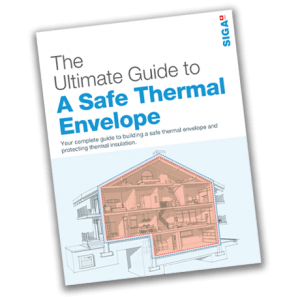The Ultimate Guide to
A Safe Thermal Envelope
DOWNLOAD GUIDE
Room air humidity, whether from construction or everyday use, can enter building components through diffusion or convection, leading to condensation on cooler surfaces and potential mould growth.
Room humidity, such as increased room air humidity during the construction period, but also “normal” room air humidity during normal use, can enter a building component by diffusion or convection. This then leads to condensation on cooler surfaces.
During diffusion, water vapour particles migrate through the building component layers. The motor of diffusion is the attempt to create a balance between high vapour pressure (on the inside of the room in winter) and low vapour pressure (on the outside of the building in winter). A vapour control layer such as SIGA Majrex® slows down this water vapour migration and thus protects the construction from too much moisture.
In contrast, in convection, warm air flows into cooler areas of the construction due to leaks / leakages of the non-airtight building envelope. Warm air is a super transporter that can carry not only thermal energy but also large quantities of water vapour. If this flow of warm air meets cooler layers in the building component, considerably more condensation water is produced than by water vapour diffusion.
These two transport routes of moisture from the inside of the room into the layers of the building component are known to many building professionals like you. With great care, the suitable vapour control layer is connected to other building components in an airtight manner and a blower door test proves this: Everything is airtight! We undergo a blower door test to measure the airtightness of the building envelope, to check if we have done a correct installation.
And if it does get mouldy, then it could possibly be due to flank diffusion and flank convection.

Even if an integrated building component (for example a plastered masonry) is airtight, this airtight seal is often missing in the area on the top of the wall. The masonry is even more damp in the first years after completion of a building. This moisture dries out and migrates into the construction. Let’s take an inner wall that protrudes into a flat roof built in lightweight construction. The top of the wall is a source of moisture. It pushes upwards into the construction layers above,, such as wooden formwork. If a vapour-tight bitumen sheeting lies on top of this wooden formwork, the moisture cannot escape outwards via the way of moisture diffusion. The resulting condensation water is stored in the timber and can lead to mould growth under certain circumstances.

Flank diffusion | water vapour molecules enter the insulation through a building component and can cause ugly moisture damage.
On the path of flank convection, more moisture can enter a roof construction compared to flank diffusion. Flank convection means that a convective / airtight separation between two layers of building components is missing. The usual suspects here are: an unplastered top of the wall in the case of hollow bricks, double-skin masonry, a composite thermal insulation system applied to an external wall (air flow between the masonry and the external insulation) or an internal wall insulation that can be trapped by room air.

Flank convection | moisture enters through gaps or leaks and in the worst case causes moisture damage.
Moisture that is introduced into an insulated roof construction by flank diffusion can migrate back into the interior. Requirement here: Use a directionally moisture-variable vapour control layer with a very high potential for drying of the construction.
Against increased moisture ingress through flank convection, make sure to:

HR Marketing and Employer Branding Manager on a mission to position SIGA as a great employer. Outside of work, she enjoys immersing herself in the world of books, passionately practices yoga, and is a proud mum.
Added to my cart